Facebook ads have taken the social media ad world by storm. And why not? A marketer can easily target a particular section of their 900+ million users on Facebook. But, with so many ad options, how do you know which Facebook ad type suits your marketing goal?
In earlier posts, I have discussed how a business owner or a marketer can Create Facebook Ads (Basic News Feed ad) and Set up Facebook Conversion Tracking. In this post, I will discuss about Advertising on Facebook and how each type can be used for specific marketing goals.
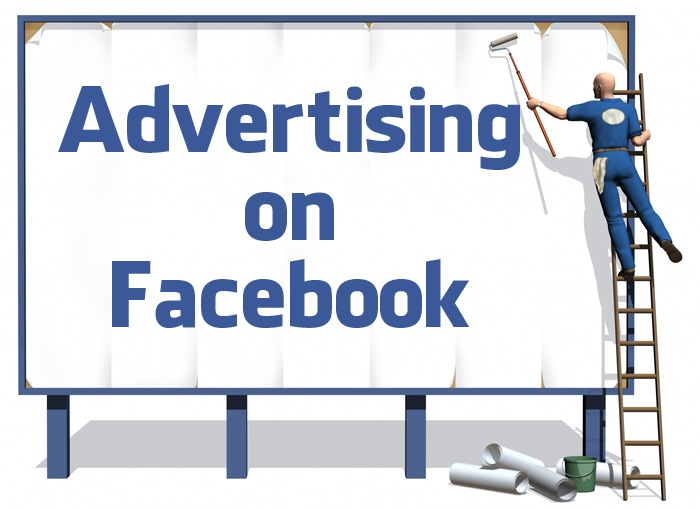
1. Marketplace/Standard Ads:
Marketplace ads are the most familiar ones on Facebook and an advertiser has full control of the ad’s creative elements – headline, body content and image. These ads can be seen on the right hand sidebar of your regular news feed page. The ad should be limited to 292 pixels x 154 pixels for an image, 90 characters for the body text and 25 characters for the title. This is how the ad looks:
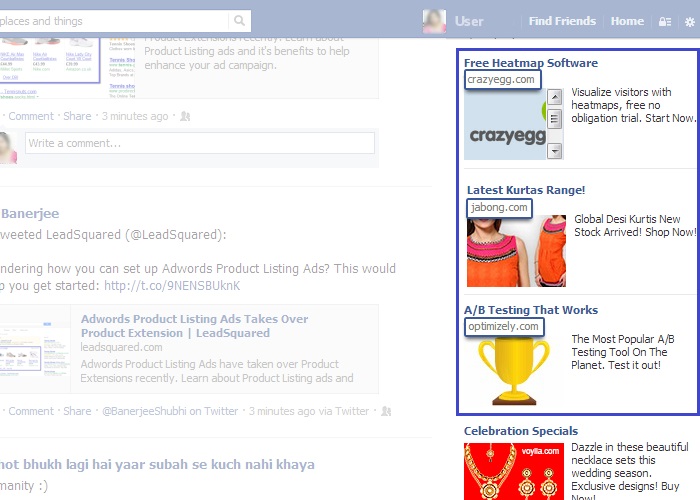
Key Features:
| 1 | In these ads, you can drive users to your website. It can be an external URL or any other page on Facebook. If you take a closer look at the image, you will see that just below the ad headline, the website has also been mentioned. |
| 2 | Marketplace ads drive user engagement by letting users see how many of their friends have ‘liked’ a page. If a friend of a user likes a page, the same will pop up on the users’ home page. This increases the chances of the user visiting the page and potentially converting. |
Use this ad type if your marketing goals are:
![]() Lead Generation: This type of ad allows you to drive visitors to an external landing page; therefore you can use it to land your visitors to a lead collection page (with a ‘Sign Up’ form). Because of the targeting options, you can target the ads perfectly (well, almost), so that each click is relevant. For instance, if you are targeting tech savvy folks, within a certain age-group, Facebook allows you to do that, using broad and precise targeting options.
Lead Generation: This type of ad allows you to drive visitors to an external landing page; therefore you can use it to land your visitors to a lead collection page (with a ‘Sign Up’ form). Because of the targeting options, you can target the ads perfectly (well, almost), so that each click is relevant. For instance, if you are targeting tech savvy folks, within a certain age-group, Facebook allows you to do that, using broad and precise targeting options.
Example: An author who has written a romantic novel keeping adolescents and young adults in mind, he/she can very well target the same group based on demographics, geographic location, age group etc. Thanks to the Precise Interests targeting, the targeting can be done by typing specific keywords, like Reading, Novels, Romantic Movies etc.
![]() Increase sales: These ads are perfect for B2C marketers to lead users onto their e-commerce websites.
Increase sales: These ads are perfect for B2C marketers to lead users onto their e-commerce websites.
Example: E-commerce sites like Jabong, eBay, Voylla etc, drive users directly to their online shopping sites when they click on their ads on Facebook.
![]() Brand Awareness: These ads help enhance brand awareness. Since this ad does not have the option of ‘Like’, an enticing ad caption & image can get curious users to click on the ad, visit your page and engage.
Brand Awareness: These ads help enhance brand awareness. Since this ad does not have the option of ‘Like’, an enticing ad caption & image can get curious users to click on the ad, visit your page and engage.
Example: With several online shopping portals/small businesses cropping up by the day, it may not be possible for all Facebook users to know each one of them. These ads are an easy way to get users onto a freshly launched website/landing page.
2. Sponsored Ads:
These ads are built around user activity. A marketer pays to highlight an action (like, comment and share) that a user has taken and then that action is shown to a users’ friends and their friends.
Let us take it one step at a time to make it easier to understand:
i) A Facebook User (let’s call him ‘A’) likes a Post on a new Company’s Facebook Page (let’s call the company XYZ Co.).
ii) This action can now be advertised by ‘XYZ Co.’ using Sponsored Ads, to A’s friends and friends’ friends.
Check out the image below. Because someone on my friend list has ‘liked’ Samsung Mobile’s Facebook Page, a sponsored ad appears in my newsfeed, letting me know of the action.
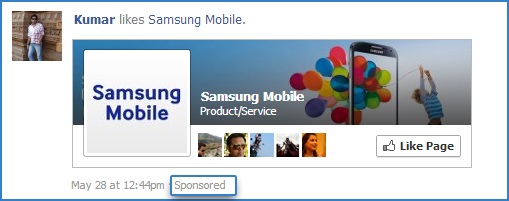
Now Samsung Mobile we all know of, but let’s think of XYZ Co. again. They are just trying to spread awareness about themselves. So, if on A’s friend’s newsfeed something similar to this shows up, there is a good chance that the ad would get clicked, or the page liked.
Key Features:
| 1 | You can target a particular section of the audience by narrowing down the specifications while creating the ad. | |
| 2 | Sponsored advertising on Facebook is available for both business profiles and pages. | |
| 3 | Such ads are triggered by actions like, liking, commenting, sharing, installing an app, joining an event or liking/sharing a website. So when a friend does any of the above mentioned activity on an ad, it will show up on the users’ news feed. Promoted posts are labelled ‘Sponsored’ posts either on the right hand column or on the desktop of your news feed page. | |
| 4 | Unlike a marketplace ad where you cannot ‘like, ‘comment’ or ‘share’ an ad, a sponsored ad lets you do that. This enhances exposure and your ad gets new fans. |
Use this ad type if your marketing goals are:
![]() Getting more likes: There is a ‘Like’ button in the ad itself. Apart from liking the ad, this ad can also be used to take a user to the landing page/sign up page.
Getting more likes: There is a ‘Like’ button in the ad itself. Apart from liking the ad, this ad can also be used to take a user to the landing page/sign up page.
![]() Brand Awareness: Expose your site/brand name to like-minded people.
Brand Awareness: Expose your site/brand name to like-minded people.
Example: When a friend likes a page, it shows up on the users’ news feed. The user might be interested in what his/her friend has liked and visits the page/profile.
However, over the next few months, Sponsored Stories, one of Facebook’s more insidious ad campaigns will slowly be cut out.
3. Page Post Ads
Page Post Ads are geared towards small business owners/starters who are looking for a foothold in Facebook. These ads can include links, photos, videos, offers, events or even questions. These ads come as ‘Recommended Pages’ on your right side bar on your news feed. Whenever your fans are online, they will be shown your post in the form of an ad.
See the image below.
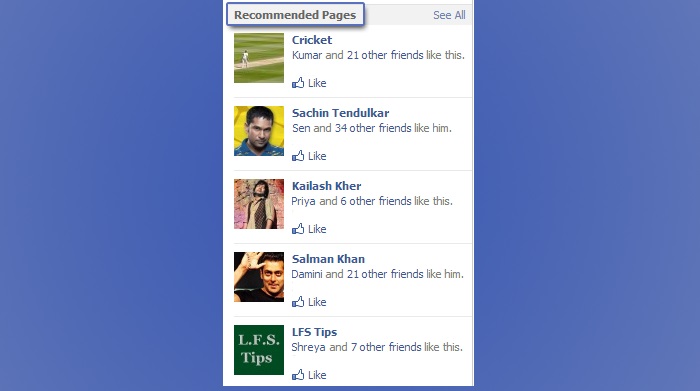
Go to your timeline, can you see the text which reads, ‘Create an ad to get more people to like your Page’ and a budget drop down box? Click on this to increase your page likes. Your budget can range from $5 to $50 depending on the amount of ‘Likes’ you want to get.
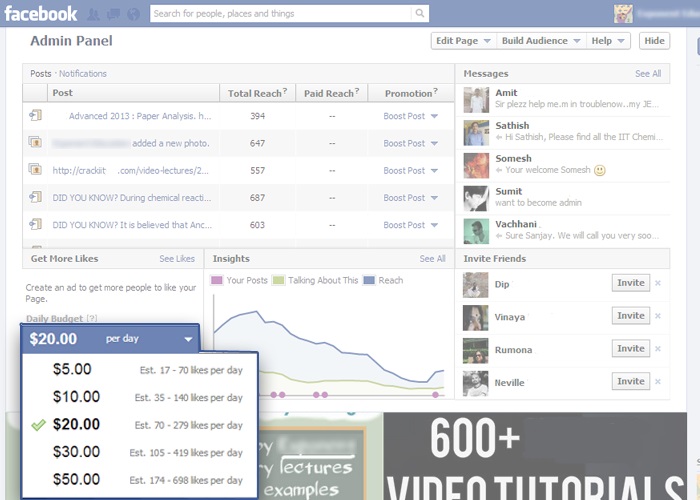
Key Features:
| 1 | Users are directly led to the particular page once they click on the ad. This helps make the content on the page go viral and engage more users. The ad is just a way of driving more users to ‘like’ your page. | |
| 2 | These ads are aimed at small business owners/starters who do have the time to go through the elaborate process of creating ads or are looking to gain foothold on Facebook. |
Use this ad type if your marketing goals are:
![]() Driving Engagement & Brand Awareness: These ads are visible to anyone who is on Facebook. Unlike marketplace ads, a user can like, share and comment on the ad itself without being swayed into an external URL and it also shows any action that has been taken by a friend.
Driving Engagement & Brand Awareness: These ads are visible to anyone who is on Facebook. Unlike marketplace ads, a user can like, share and comment on the ad itself without being swayed into an external URL and it also shows any action that has been taken by a friend.
Example: Like you can see from the image shown above and the name of the ad suggests, page post ads are mostly added by celebrities, fans who create Pages for celebrities, communities & groups, fan page etc. Advertisers can specifically target a group of people with these ads.
![]() Get more likes: The most important aspect of this ad is to get more likes on your page.
Get more likes: The most important aspect of this ad is to get more likes on your page.
Example: A new product/service in the market can advertise on Facebook and build on their brand awareness. This ad is almost a sure shot way of attracting new fans through ‘Likes’.
4. Promoted Ad Post:
Like the name suggests, these Facebook ads allow you to promote anything that you can create through the status sharing bar. When you are updating your status – photos/videos, offers/ event/milestone/questions, click on the ‘Boost Post’ button to promote the feed. The cost of a promoted post can range from anything between $5 and go up to $300, depending on the target you choose. The farther you want your ad to reach, the more you shell out.
Over the last few months Facebook has been on a drive to simplify things on their site and prevent marketers from getting confused. Facebook will soon be removing the option of posting ‘Questions’. Marketers can simply ask their questions in a regular post and get answers through comments.
Key Features:
| 1 | This ad appear in News Feeds and not on the right-hand column of a news feed page where they might be neglected by some users. |
| 2 | These ads are also easy to set up and work well for promoting events, special offers and engaging images. |
| 3 | But, here’s the catch – you can promote a post only when your page has 400 or more likes. |
Here is an example. In the image below see how by increasing your budget, you can increase your target reach.
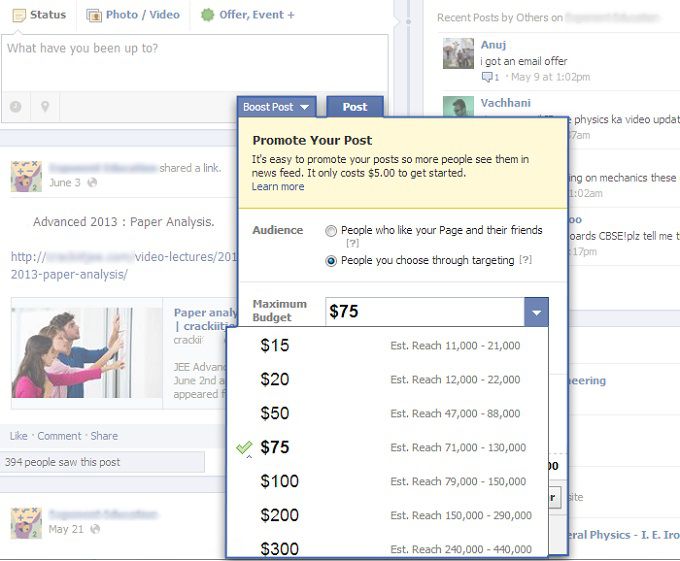
Use this ad type if your Marketing Goals are:
![]() Get more likes: To help push the ad content to more fans who would not have organically seen your content.
Get more likes: To help push the ad content to more fans who would not have organically seen your content.
![]() Drive Engagement: To increase engagement on your page. You can set your budget based on the estimated reach you have in mind. (Like $300 can reach your ad to 240000 to 440000 people).
Drive Engagement: To increase engagement on your page. You can set your budget based on the estimated reach you have in mind. (Like $300 can reach your ad to 240000 to 440000 people).
![]() Lead Generation: This ad type lets you promote a new post that needs lead generation, like a webinar, competition or an event.
Lead Generation: This ad type lets you promote a new post that needs lead generation, like a webinar, competition or an event.
Here is a table to quickly summarize things for you:
| Marketplace Ads | Sponsored Ad | Page Post Ad | Promoted Ad | |
| What can you promote? | Facebook pages, Apps, Events, External URL | Facebook Pages | Posts from your Facebook Page | Any post on your Facebook page |
| What is the content? | Image, headline and content text created by you | Stories from Facebook about your page | Page post including comments, likes & shares | Page post including comments, likes & shares |
| Where are they placed? | Sidebar | Side bar and desktop news feed | Side bar and desktop news feed | Desktop news feed |
| Whom can you target? | Everyone regardless of whether they are connected to your page or not | Can target any user (or friends) connected to your page | Everyone regardless of whether they are connected to your page or not | Everyone on Facebook |
| Where can you buy them? | Facebook.com/ads | Facebook.com/ads | Facebook.com/ads | Below each post on your page |
Like you can see above, there is an ad for each situation. Striking the right chord is all that it takes for leads to flow in and enhance the visibility of your brand through Facebook.
Add custom tabs on your Facebook pages that link to LeadSquared’s landing pages here.






